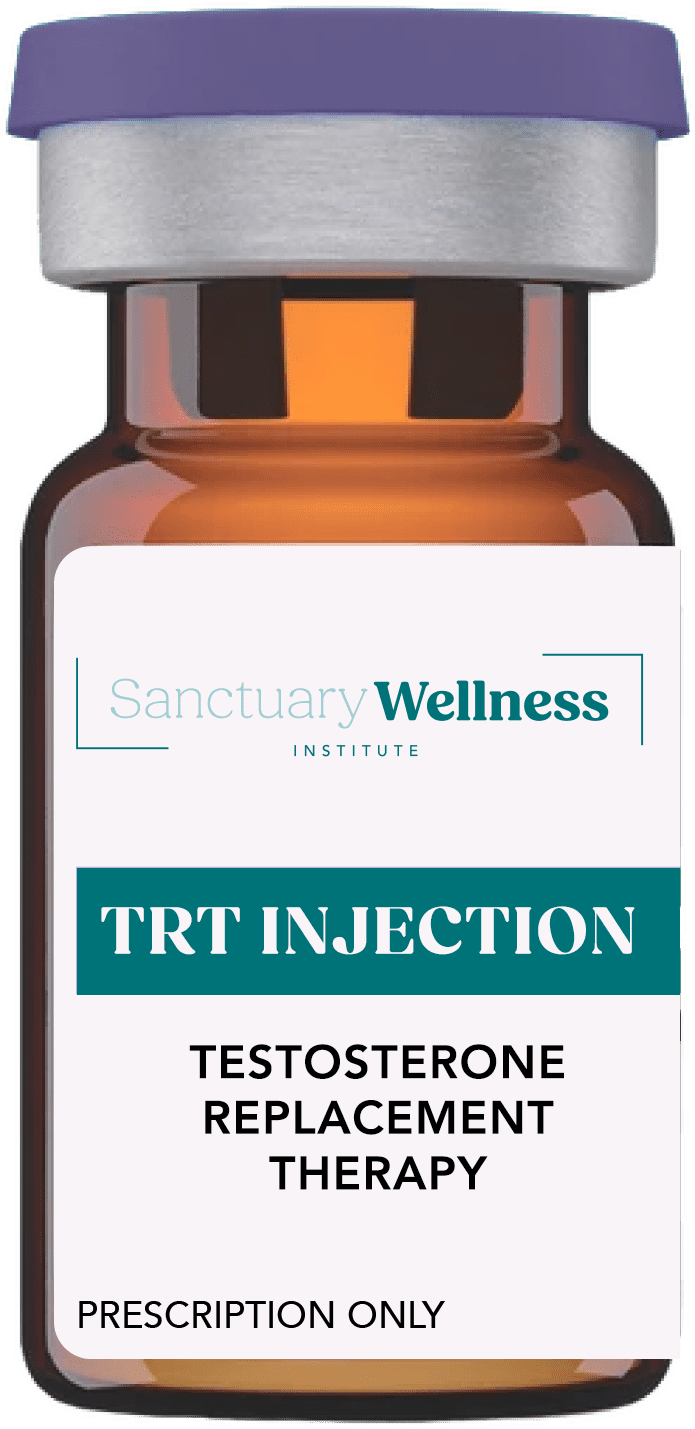Increase
Energy
Improve
Libido
Build
Muscle
Get Started for Only $97/month + meds
No payment required prior to initial consultation
Speak to a specialist (304) 337-5230
Testosterone Replacement Therapy (TRT) is a medically supervised treatment designed to restore healthy testosterone levels in men experiencing symptoms of Low T.
Testosterone plays a vital role in maintaining energy, muscle mass, mood stability, cognitive function, and sexual health. When levels decline, it can significantly impact overall well-being and quality of life.
Our testosterone therapy in Charleston, WV is a personalized TRT program based on comprehensive hormone testing and individual health assessments. Each treatment plan is custom-tailored to safely optimize hormone levels, relieve symptoms, and support long-term vitality.

We specialize in testosterone replacement therapy in Charleston, WV, helping men realize their full performance potential with once-weekly injections.

We believe in full transparency and affordable TRT in WV. For this reason we charge you for telehealth services only. You pay the pharmacy directly.
Simple and Convenient

No payment is required prior to your inital consultation. You will discuss your goals with the doctor and receive an order for blood work.

Meet with our TRT doctor for a short telehealth appoinment to review your lab results and discuss the details of your treatment plan. The doctor will explain potential side effects, answer any questions, and outline what to expect from TRT.

You will then be referred to a pharmacy, who will handle payment and fulfillment of any applicable medication. Your medication will be shipped directly to you at your home, along with clear instructions for self-administration. You may also have you prescription sent to your local pharmacy for pick up.

300 Capitol St Suite 407
Charleston, WV 25301
Phone: (304) 337-5230
| Monday | 9:00 AM – 5:00 PM |
|---|---|
| Tuesday | 9:00 AM – 5:00 PM |
| Wednesday | 9:00 AM – 5:00 PM |
| Thursday | 9:00 AM – 5:00 PM |
| Friday | 9:00 AM – 5:00 PM |
| Saturday | 10:00 AM – 2:00 PM |
| Sunday | Closed |
Head southeast on I-79 S 2.0 mi Use the right lane to merge onto I-77 S 1.5 mi Use the right lane to take exit 101 for I-64 W/US-119 S toward Huntington 0.2 mi Take the 58c exit toward US 60/Washington St/Civic Ctr 0.2 mi Merge onto US-119 S 0.1 mi Slight left onto US-119 S/Pennsylvania S 0.2 mi Turn left onto US-60 E/Lee St Destination will be on the left
Head southeast on MacCorkle Ave SE toward 47th St SE 82 ft Turn right at the 1st cross street onto 47th St SE 174 ft Turn right toward 46th St SE 459 ft Turn right onto 46th St SE 174 ft Turn left onto MacCorkle Ave SE/McCorkle Ave 0.9 mi Turn right onto 36th St SE Pass by Subway (on the left) 0.2 mi Continue onto 36th St Southeast Bridge 0.2 mi Use the right lane to take the ramp onto I-64 W/I-77 N 1.9 mi Take exit 100 to merge onto Leon Sullivan Way 0.6 mi Turn right onto Washington St E 0.3 mi Turn left onto Summers St 358 ft Turn left at the 1st cross street onto Lee St Destination will be on the left 446 ft
Take E St to US-60 E/MacCorkle Ave SW 24 sec (341 ft) Head northeast toward E St 161 ft Turn right at the 1st cross street onto E St 180 ft Turn left at the 1st cross street onto US-60 E/MacCorkle Ave SW 2 min (0.7 mi) Get on I-64 E 2 min (0.6 mi) Turn right onto A St/Montrose Dr 0.2 mi Use the left lane to continue on Montrose Dr 0.1 mi Turn left to merge onto I-64 E toward Charleston 0.3 mi Continue on I-64 E. Drive to US-60 E/Lee St W in Charleston 5 min (3.1 mi) Merge onto I-64 E 2.2 mi Take exit 58C for US-60 toward Lee St 0.3 mi Turn right onto US-60 E/Lee St W Parts of this road may be closed at certain times or days Destination will be on the left 0.7 mi
By adjusting hormones levels to their optimal balance, men can experience significant improvements in health and overall well-being:

Improved Energy Levels
TRT combats fatigue, boosting energy, stamina, and daily productivity.

Increased Sex Drive and Function
Restores libido and improves sexual performance, enhancing desire and intimacy.

Enhanced Muscle Mass and Strength
Supports muscle growth and strength, leading to a leaner physique, especially with exercise.

Weight Loss & Body Composition
Aids in fat loss, particularly around the abdomen, and improves metabolism for a healthier muscle-to-fat ratio.

Improved Bone Density
Strengthens bones and reduces the risk of fractures and osteoporosis.

Better Mood and Cognitive Function
Stabilizes mood and enhances mental clarity, improving focus, memory, and emotional well-being.

As with all medical treatments, outcomes vary from patient to patient. This is a rough outline of what the majority of patients experience:
Initial Changes
You may start to notice subtle improvements in your energy levels and mood. Many men experience a boost in motivation, better focus, and a slight increase in libido.
Improved Energy and Libido
Energy levels continue to rise, and improvements in libido often become more noticeable. You may start to see better sleep patterns and mood stability. Some individuals also experience early signs of muscle tone enhancement.
Increased Muscle Mass and Strength
Physical changes often become more visible. Muscle mass and strength begin to increase, especially if combined with regular exercise. Many men report improved stamina, better recovery after workouts, and a general sense of well-being. Libido and sexual function typically continue to improve during this time.
Stabilized Energy and Mood
Energy levels and mood become more consistent and stable. This is when many men feel their motivation and overall vitality have significantly improved. Muscle strength continues to develop, and you may notice better endurance during physical activities.
Enhanced Physical and Mental Health
The benefits of TRT are usually well-established. You can expect to see further improvements in muscle mass, fat loss, and physical performance. Mentally, you may feel sharper, with better focus and cognitive clarity.
Optimized Results
By the sixth month, you should be experiencing the full effects of TRT. Energy, libido, muscle growth, and overall mood will likely have reached their peak improvement. Regular monitoring with your TRT doctor ensures that your dosage and treatment plan are optimized for long-term health and continued success.
While Testosterone Replacement Therapy (TRT) can offer significant health benefits for men with clinically low testosterone, it’s important to understand that all hormone therapies carry potential side effects. Proper medical supervision, ongoing lab testing, and dosage adjustments help minimize these risks and ensure treatment safety.
Common side effects may include:
In some cases, TRT may affect cholesterol levels, prostate health, or sleep patterns, particularly in individuals with preexisting conditions. That’s why regular blood monitoring, prostate screening, and cardiovascular assessments are essential parts of any medically supervised TRT program.
At The Sanctuary Wellness Institute, all TRT treatments are personalized and closely monitored by licensed healthcare professionals to ensure both safety and effectiveness.
At The Sanctuary Wellness Institute, patient safety is at the core of every Testosterone Replacement Therapy (TRT) program. All treatments are physician-supervised and personalized based on comprehensive lab testing, medical history, and ongoing evaluation.
Throughout therapy, patients receive regular monitoring of hormone levels, blood counts, cholesterol, and prostate health to ensure safety and effectiveness. Our clinical team provides detailed instruction on proper administration, dosage, and follow-up care.
Yes. After your online TRT evaluation and provider approval, your medication is dispensed by a licensed U.S. pharmacy and shipped directly to your Charleston home in secure, discreet packaging with tracking.
No. Your entire TRT plan—consultations, treatment adjustments, and follow-up care—is handled through secure telehealth, so no in-person clinic visit is required.
No. Residency isn’t required. You only need to be physically located in a state where our licensed providers practice at the time of your virtual appointment.
With the help of our men's health doctors you can achieve your goals and unlock your potential. Schedule a brief intake appointment to get started. Afterward, you'll receive a lab order for blood work, which your doctor will review at your next appointment. It's that simple!